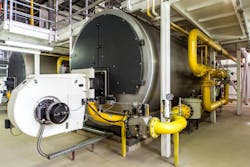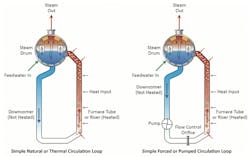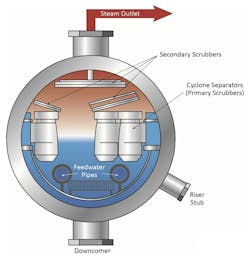The importance of industrial water and steam treatment, Part 6
The previous installments of this series have focused on the influence of impurity ingress and feedwater/boiler water chemistry control on steam generator scale formation and corrosion. Not to be neglected is steam chemistry. Impurity carryover can cause great damage in steam networks and particularly to steam turbines. This article examines many of the most important issues in this regard.
Drum boiler circulation and modes of impurity ingress
Many industrial boilers are of the drum type, whose core circuitry and fluid patterns are outlined in Figure 1.
Lower-pressure boilers are typically of the natural circulation type, while high-pressure utility drum boilers are often forced-circulation to ensure adequate flow through the boiler tubes.
The key to drum boiler design is the separation of steam from the circulating water per the density difference between liquid and gas. This difference decreases with increasing pressure, and for utility supercritical boilers with a single-phase fluid, the drum concept becomes invalid.
Impurities can enter drum boiler steam through several potential pathways:
- Mechanical carryover.
- Vaporous carryover.
- Direct admittance via attemperator sprays used for steam temperature control.
- Decomposition of some water treatment chemicals, usually alkalizing amines.
- Exfoliation of iron oxides from steam piping.
Carryover examples
We will now explore the mechanisms listed above and some of the primary difficulties they can cause in steam systems.
Mechanical carryover
Mechanical carryover is usually the issue of greatest concern. To a lesser or greater extent depending upon boiler pressure and design, the steam drum contains a combination of internal water-steam separators to remove entrained water droplets and return them to the drum water. Figure 2 shows common separating devices.
Even with well-designed water/steam separators, steam leaving the boiler drum will contain entrained moisture. Figure 3 illustrates the general relationship between moisture carryover and boiler pressure.
This aspect plays a large part in boiler water chemistry guidelines, which Table 1 graphically illustrates.
Note that the “Maximum Suggested Target Specific Conductance” category specifically references steam purity. The values dramatically decrease with increasing pressure, and for the high-pressure circuit of a modern combined cycle heat recovery steam generator (HRSG) may be below 25 µS/cm.4 Note also in Table 1 the “Superheated Steam Purity Target” of <20 ppb in all cases. Several research organizations have developed steam purity guidelines for high-pressure utility units. Table 2 outlines core values from the International Association for the Properties of Water and Steam (IAPWS).
For years, conductivity after cation exchange (CACE) has served as an indirect measurement of chloride and sulfate. On-line instruments are now available to analyze trace concentrations of these species.6 If Cl and SO4 were included in the table above, the target value would be equivalent to sodium, <2 mg/kg. (Note: The unit mg/kg is essentially equivalent to parts-per-billion (ppb)). Some researchers consider these sodium, chloride and sulfate values to be too high, as over time deposits can accumulate in the last stages of the low-pressure turbine and initiate corrosion.
Apart from the boiler water dissolved solids influence on steam purity, the following list highlights other mechanisms that can lead to excessive carryover:
- Damaged steam separators.
- Foaming compounds in the boiler water.
- High drum water level/malfunctioning drum level instrumentation and control.
- Excessive load swings.
Nearly always recommended during planned unit outages are visual inspections of steam drum internals including steam separators. The plant maintenance team should have procedures in place and parts on hand to replace damaged components.
A foaming/carryover example
Readers should note in Table 1 the low feedwater TOC (total organic carbon) guidelines. Natural organic compounds can sometimes enter utility steam generating systems with makeup if not removed by the makeup treatment system, or they can be generated by decomposition of alkalizing amines used for feedwater pH conditioning. Additional thoughts on the influence of the TOC in high-pressure steam generators are available in Reference 5.
The potential for organic compound (and other materials) ingress is potentially much greater in industrial systems with condensate return from process heat exchangers. Consider the following example. A number of years ago, the author and a colleague visited an organic chemicals plant that had four 550-psig package boilers with superheaters. The steam provided energy to multiple plant heat exchangers, with return of most of the condensate to the boilers. Each of the boiler superheaters were failing every 1.5 to 2 years from internal deposition and subsequent tube overheating. Inspection of a discarded superheater tube bundle in a laydown yard revealed deposits of approximately ⅛–¼ inches in depth. Additional inspection revealed foam issuing from the saturated steam sample line of every boiler. Past water/steam chemistry analyses performed by an outside vendor included data showing total organic carbon (TOC) concentrations of up to 200 mg/L in the condensate return. Contrast that with the <0.5 mg/L feedwater TOC recommendation from Table 1. No treatment processes or condensate polishing systems were in place to remove these organics (five phenol derivatives) upstream of the boilers. Based on the TOC data alone, it was understandable why foam was issuing from the steam sample lines, and why deposits accumulated in the superheaters and cause overheating failures.
Vaporous carryover
A few compounds, and most notably silica, will carry over into steam as vapor. Silica is not corrosive, but deposits can impact turbine aerodynamics. The extent of silica carryover is a direct function of boiler pressure and becomes pronounced at utility boiler pressures, thus the 10-ppb limit recommended in Table 2.
Copper compounds will also carry over vaporously to steam, especially at pressures above 2,000 psi. The copper then deposits on high-pressure turbine blades. Even just a few pounds of copper deposition can significantly reduce aerodynamic efficiency. Copper carryover was, at one time, a significant issue with coal-fired units, as many of these had copper-alloy feedwater heater tubes. The continuing retirement of coal-fired plants and their replacement with combined cycle generation has, in large measure, eliminated this problem.
Direct impurity introduction from attemperator sprays
Especially for utility steam generators, precise control of steam temperatures is important to maximize efficiency and keep metal temperatures below levels that can cause premature degradation and failure. Most units are equipped with attemperator systems that spray a small amount of boiler feedwater into the main and reheat steam. This arrangement provides a direct path for contaminant introduction to superheaters, reheaters and turbines. Minimizing feedwater impurity ingress takes on double importance due to this aspect, but so does chemical treatment. Volatile compounds such as ammonia or an ammonia/alkalizing amine blend are a must for feedwater pH control.7 Yet, as the author can directly attest, design specifications have appeared where the preparers suggested caustic feed for feedwater pH control. This arrangement can introduce the most corrosive compound of all directly to turbines.
Steam piping exfoliation
Steam piping and superheater/reheater tubing develop an iron oxide layer during operation. Excessive temperatures and frequent cycling can generate thick oxide layers that may spall in various locations. The particulates are then carried downstream to the turbine. Even though turbines have inlet screens for protection, fine particulates can still enter the turbine and cause abrasion, particularly in the high-pressure stages. The author has also seen iron oxide and sodium phosphate compounds (from boiler water treatment) that collected in reheater U-bends and caused overheating failures.
Conclusion
Proper control of steam generation chemistry is just as critical as that for boilers, if not more so. A turbine failure will shut a unit down for months at enormous cost for materials replacement and lost production. Much more importantly, a blade failure with the turbine in operation usually is catastrophic and jeopardizes employee safety. And, as a direct example in this article illustrates, steam chemistry upsets in lower-pressure systems can be very problematic.
References
1. B. Buecker (Tech. Ed.), “Water Essentials Handbook”; 2023. ChemTreat, Inc., Glen Allen, VA. Currently being released in digital format at www.chemtreat.com.
2. Tomei, G.L., Ed., Steam, its generation and use, 42nd edition, The Babcock & Wilcox Company, Barberton, Ohio, 2015.
3. Consensus on Operating Practices for the Control of Feedwater and Boiler Water Chemistry in Industrial and Institutional Boilers, 2021, The American Society of Mechanical Engineers, New York, NY.
4. Comprehensive Cycle Chemistry Guidelines for Combined Cycle/Heat Recovery Steam Generators (HRSGs). EPRI, Palo Alto, CA: 2013. 3002001381.
5. International Association for the Properties of Water and Steam, Technical Guidance Document: Steam Purity for Turbine Operation (2013).
6. B. Buecker, “Monitoring of Water and Steam Chemistry for Steam Generators”; Chemical Engineering, September 2019.
7. Shulder, S., and B. Buecker, “Remember the 3Ds of Alkalizing Amines: Dissociation, Distribution, and Decomposition”; PPCHEM JOURNAL, 2023/01.
Brad Buecker is president of Buecker & Associates, LLC, consulting and technical writing/marketing. Most recently he served as senior technical publicist with ChemTreat, Inc. He has over four decades of experience in or supporting the power industry, much of it in steam generation chemistry, water treatment, air quality control and results engineering positions. He can be reached at [email protected].
About the Author

Brad Buecker
Brad Buecker currently serves as Senior Technical Consultant with SAMCO Technologies. He is also the owner of Buecker & Associates, LLC, which provides independent technical writing/marketing services. Buecker has many years of experience in or supporting the power industry, much of it in steam generation chemistry, water treatment, air quality control and results engineering positions with City Water, Light & Power (Springfield, Illinois) and Kansas City Power & Light Company's (now Evergy) La Cygne, Kansas, station. Additionally, his background includes 11 years with two engineering firms, Burns & McDonnell and Kiewit, and he spent two years as acting water/wastewater supervisor at a chemical plant. Buecker has a B.S. in chemistry from Iowa State University with additional course work in fluid mechanics, energy and materials balances, and advanced inorganic chemistry. He has authored or co-authored over 300 articles for various technical trade magazines, and he has written three books on power plant chemistry and air pollution control. He is a member of the ACS, AIChE, AIST, ASME, AWT, CTI, and he is active with Power-Gen International, the Electric Utility & Cogeneration Chemistry Workshop, and the International Water Conference. He can be reached at [email protected] and [email protected].





